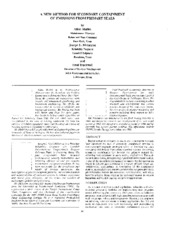| dc.contributor.other | International Pump Users Symposium (15th : 1998) | |
| dc.creator | Mathis, Allan | |
| dc.creator | Melancon, Joseph L. | |
| dc.creator | Trackwell, Fred | |
| dc.date.accessioned | 2017-10-05T16:53:13Z | |
| dc.date.available | 2017-10-05T16:53:13Z | |
| dc.date.issued | 1998 | |
| dc.identifier.uri | https://hdl.handle.net/1969.1/164108 | |
| dc.description | Lecture | en |
| dc.description | pg. 69 | en |
| dc.description.abstract | Recent industrial advances in secondary containment methods have increased the role of secondary containment systems in environmental corporate strategies aimed at lowering the risks associated with leakage from primary sealing systems. As a result, secondary containment has become the primary method for achieving zero emissions in many sealing applications. The seal-assist system (SAS), incorporating a patented entrainment system, is one of the secondary containment advances that has proven its ability to achieve zero emissions in a variety of both rotary and reciprocating applications. A description of the entrainment system, its potential uses, and two plant studies are presented. Both plant histories discuss the economic, environmental, and safety benefits achieved from utilizing the seal-assist system in various hazardous and volatile organic compound applications. | en |
| dc.format.medium | Electronic | en |
| dc.format.mimetype | application/pdf | |
| dc.language.iso | en | |
| dc.publisher | Texas A&M University. Turbomachinery Laboratories | |
| dc.relation.ispartof | Proceedings of the 15th International Pump Users Symposium | en |
| dc.subject.lcsh | Pumping machinery | en |
| dc.title | A New Method For Secondary Containment Of Emissions From Primary Seals | en |
| dc.type.genre | Presentation | en |
| dc.type.material | Text | en |
| dc.identifier.doi | https://doi.org/10.21423/R1XH5Q | |


